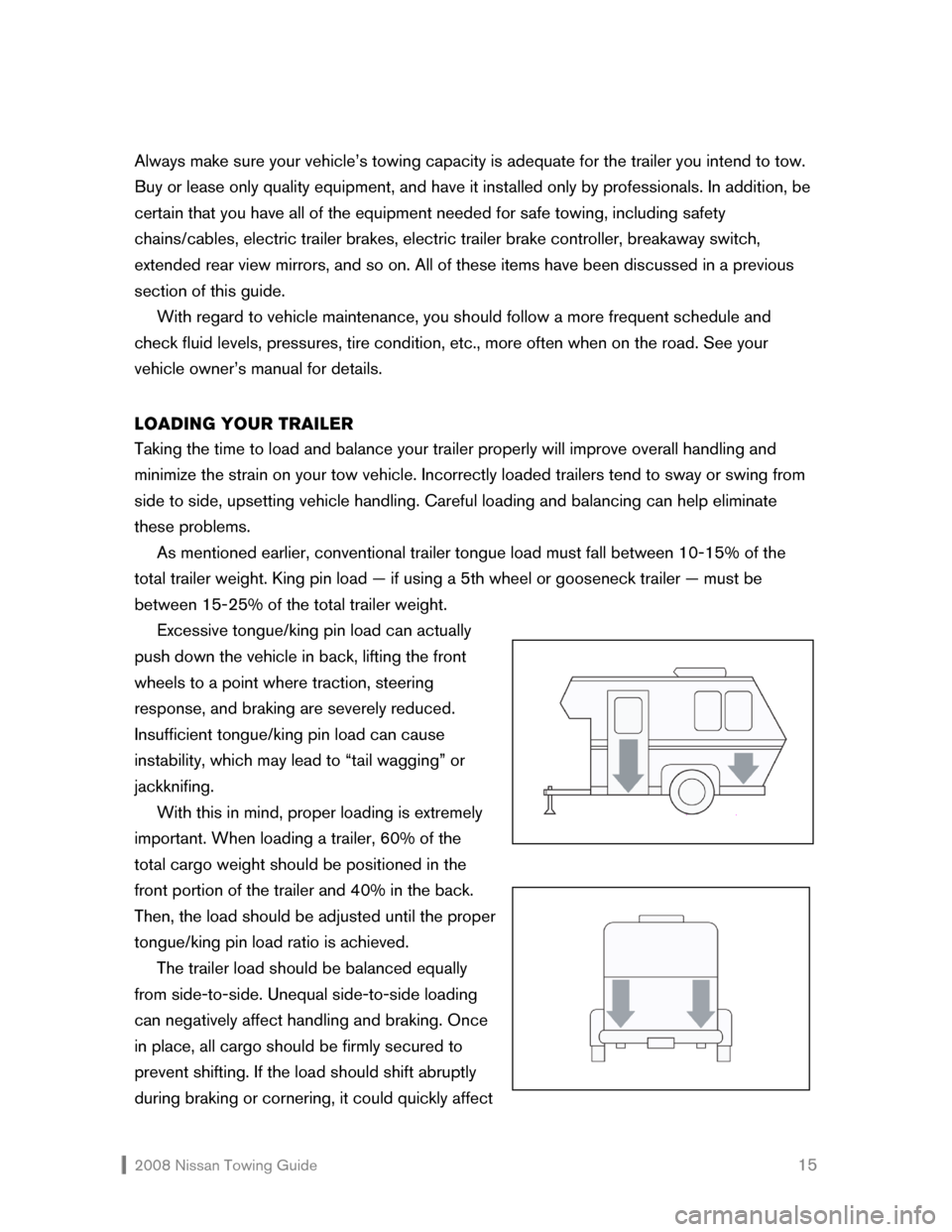brake NISSAN FRONTIER 2008 D22 / 1.G Towing Guide
[x] Cancel search | Manufacturer: NISSAN, Model Year: 2008, Model line: FRONTIER, Model: NISSAN FRONTIER 2008 D22 / 1.GPages: 32, PDF Size: 1.16 MB
Page 2 of 32

2008 Nissan Towing Guide 1
INTRODUCTION
SAFETY IS PRIORITY ONE
Obviously, your first concern should be safety. Your vehicle was designed to be used primarily
to carry passengers and cargo. Always remember that towing a trailer places additional loads
on your vehicle’s engine, drivetrain, steering, braking, and other systems. Therefore, be certain
that your vehicle can meet the demands of the towing application you have in mind.
Rent or purchase only the highest-quality towing and safety equipment you can find.
Reinforced tow hitches designed especially for certain Nissan vehicles are available from your
Nissan dealer.* Hitches for the other Nissan models should be bought from and installed by a
professional supplier of towing equipment.
Finally, it is important to follow the towing capacity limit set for your specific vehicle, and to
ensure that your vehicle is in top mechanical condition, especially the tires, brakes,
suspension, and engine cooling system. See your vehicle owner’s manual for details.
NEVER EXCEED THE ESTABLISHED TOWING CAPACITY
Towing capacities vary from vehicle to vehicle. See the SPECIFICATIONS section of this
guide for the towing capacities of 2008 Nissan vehicles produced at the time of Towing
Guide publication. Use this data to help select the proper Nissan vehicle to meet your
anticipated towing needs, and refer to it when renting a trailer or other piece of towing
equipment.
EQUIP YOUR NISSAN FOR TOWING
The frequency and type of towing should influence the manner in which you equip your vehicle.
If you plan to tow often, either for recreation or work, select the engine size, transmission type,
suspension, and towing capacity that are best suited to your requirements. This guide can
help you select that equipment.
If, on the other hand, your towing will be infrequent, choose the Nissan vehicle and
equipment that best meets your day-to-day needs. Be careful not to exceed the towing
capacity on those few occasions when you do tow.
READ THIS GUIDE BEFORE YOU TOW
This guide was designed to provide an overview of safe towing practices. Here, you’ll find
information on towing equipment, safety, proper loading and driving techniques, towing tips,
and much more.
It is also a good idea to discuss your towing requirements with either your Nissan dealer or
a professional supplier of towing equipment before you equip your Nissan vehicle for towing.
*
Quest tow hitch is factory installed only.
Page 3 of 32

2008 Nissan Towing Guide 2 Finally, there are state and local laws on towing that you should review to ensure compliance
with all regulations.
TOWING
EQUIPMENT
RENTING
The first thing to keep in mind when renting a trailer is to rent only from professional
companies that specialize in towing and towing equipment. More than likely, specialized
companies hire professional staff that can assist you in selecting and installing the proper
towing equipment for your Nissan vehicle.
When renting, make sure you have your vehicle owner’s manual on hand so that you can
reference the towing capacities for your specific vehicle. Never rent a trailer that exceeds
these capacities, and make sure that any related towing equipment you rent will be sufficient
for the loaded trailer.
While you’re there, ask questions. How much does the empty trailer weigh? How much
weight will the trailer hold? What is the trailer’s tongue load? With what type of brakes is it
equipped (if any)? All of these factors have an effect on whether your Nissan vehicle is
capable of safely pulling that type of trailer or piece of equipment.
Make certain that all of the trailer stoplights, taillights, and turn signals are connected and
are operating correctly, and that all safety equipments are properly installed. Check the safety
chains/cables, tie-downs, etc.
For safer operation, carefully inspect the condition of the trailer and towing equipment.
Specifically, check to make sure the tires are not worn excessively and are properly inflated.
Make sure there are not any broken welds, missing bolts, and that the hitch components are
not damaged.
Towing safety should be a high priority when choosing and renting towing equipment,
including hitches. NEVER RENT A CLAMP-ON-TYPE HITCH. Your vehicle’s bumpers are
not designed for using this type of hitch. Using it will damage your vehicle and could even
result in the trailer separating from the towing vehicle; this can cause death or serious injury.
To avoid this, use only a permanent-type hitch.
PURCHASING
If you are buying a travel or boat trailer, be sure that your Nissan vehicle has the towing
capacity to pull it. See the SPECIFICATIONS section of this guide or refer to your vehicle
owner’s manual for detailed information regarding the towing capacity of your specific vehicle.
Page 9 of 32

2008 Nissan Towing Guide 8 to the bumper and chains/cables when making a sharp turn, do not attach the chains/cables
too close to the coupler. Consult your trailer manufacturer for the proper location of the
chain/cable attachment to the trailer.
REAR VIEW MIRRORS
In many cases, a trailer can block your rear vision when you’re using only the standard Nissan
rear view mirrors. These mirrors were not designed for towing. “Extended” mirrors specifically
designed for trailer towing should be used when your rearward vision is obstructed. Before
using these mirrors, make certain that they comply with state and local regulations.
Telescoping Tow Mirrors are available as an accessory for Armada and Titan vehicles. Contact
your Nissan dealer for details.
BREAKAWAY SWITCH
On a trailer with electric brakes, a breakaway switch can automatically activate the trailer
brake system if the trailer becomes separated from the tow vehicle. Should the trailer become
detached, a breakaway switch may help prevent the trailer from wandering into another lane
and will bring it to a safer stop with less damage.
A breakaway switch relies on the power of a trailer battery, so make sure it is not
discharged.
Never use the breakaway switch to “park” the trailer on a grade. The battery would
eventually discharge and release the brake, allowing the trailer to roll.
Be sure to leave enough slack in the tether on the breakaway switch to turn corners
without binding. If you do not, the electric trailer brakes will lock-up and not release. See your
trailer manufacturer for proper installation of a breakaway switch that is compatible with your
trailer braking system.
TRAILER LIGHTS
Trailer lights should comply with all applicable federal, state, and local regulations, and should
be in proper working order at all times. A trailer’s taillights, stoplights, and turn signals must be
wired* into the tow vehicle’s electrical system. Many trailers use the same filament of a dual-
filament bulb for both stoplights and turn signals. The second filament is used for the trailer’s
taillights. All Nissan vehicles utilize separate filaments for each function. Direct splicing of this
type of trailer lighting may cause damage to your vehicle’s electrical system and malfunction of
the trailer lighting. When connecting your Nissan vehicle to this type of trailer lighting system,
*See the SPECIFICATIONS section of this guide for wiring harness information specific to your
vehicle.
Page 10 of 32

2008 Nissan Towing Guide 9 a 3-wire to 2-wire power converter* must be used. A power converter of this type creates
only minimal additional demand (draw) on the vehicle lighting circuits to power the trailer
lighting.
Always check for correct operation of the turn signals, stoplights, and taillights every time
you connect a trailer for towing. Never replace vehicle fuses with fuses of a higher amperage
rating than the original.
NOTE – Improper or poor quality trailer harness wiring may affect your vehicle’s electrical
system. Use only a Nissan approved wiring harness, or consult your dealer or a professional
supplier of towing equipment for compatible equipment.
BRAKES
As with hitches, several types of braking systems are available. Most states require a separate
braking system on trailers with a loaded weight above a specific amount, therefore you should
check to ensure you comply with all regulations.
NOTE – Never connect a hydraulic trailer brake system directly to the vehicle hydraulic
brake system.
Surge Brakes – The surge brake is mounted on the trailer tongue with a hydraulic line
running to each trailer wheel. Surge brakes are activated by the trailer pushing against the
hitch when the tow vehicle is braking. Hydraulic surge brakes are common on rental trailers
and some boat trailers. In this type of system, there is no hydraulic or electric connection for
brake operation between the tow vehicle and the trailer.
Electric Trailer Brakes – Electric braking systems are activated by an electronic signal sent
from a trailer brake controller (special brake-sensing module).
If electric trailer brakes are used, Nissan recommends all-electronic actuation because with
this system it will not be necessary to tap into the tow vehicle’s hydraulic system.
For your convenience, Armada, Frontier, Pathfinder, and Titan vehicles are pre-wired to
accommodate most popular electric trailer brake controllers. A wiring harness** is either
included with your vehicle or available from your Nissan dealer. This harness provides electric
trailer brake controller input and output connections to the vehicle wiring. See a professional
supplier of towing equipment for electric trailer brake controller availability.
NOTE – Improper or poor quality trailer harness wiring may affect your vehicle’s electrical
system. Use only a Nissan approved wiring harness, or consult your dealer or a professional
supplier of towing equipment for compatible equipment.
*Armada LE, Frontier, Pathfinder, and Titan vehicles are pre-wired for trailer lighting and do not require
a converter.
**
See the SPECIFICATIONS section of this guide for wiring harness information specific to your
vehicle.
Page 11 of 32

2008 Nissan Towing Guide 10 SWAY CONTROL DEVICE
Sudden maneuvers, wind gusts, and buffeting caused by other vehicles can affect trailer
handling. Sway control devices may be used to help control these affects. If you choose to
use one, contact a reputable trailer hitch supplier to make sure the sway control device will
work with the vehicle, hitch, trailer and the trailer’s brake system. Follow the instructions
provided by the manufacturer for installing and using the sway control device.
GENUINE NISSAN PARTS AND ACCESSORIES
Whether you’ll be towing occasionally or on a regular basis, Nissan offers a full range of
Genuine Nissan Parts and Accessories to help you tow with confidence.
Every accessory is thoroughly tested and inspected for fit and workmanship. Therefore, you
can be certain that every item is designed to be compatible with the standard features of your
vehicle and designed to assist you with your towing needs.
Contact your Nissan dealer for more information on accessories or towing-related parts for
your Nissan vehicle.
PREPARING
YOUR VEHICLE
BREAK-IN AND MAINTENANCE SCHEDULE
Nissan recommends that you allow a sufficient “break-in” (500 miles) of both the engine and
drivetrain before towing with your new Nissan vehicle. In addition, for the first 500 miles that
you tow a trailer, do not drive over 50 mph and do not make starts at full throttle.
Keep in mind, too, that towing places higher demands and added loads on vehicle
components, so more frequent maintenance is called for. Your Nissan Service & Maintenance
Guide provides the accelerated maintenance schedule for towing purposes. Engine oil, filter,
transmission oil, and possibly other fluids should be changed more frequently when towing.
MEASURING VEHICLE WEIGHT
The key to safe, efficient towing has to do with weight. Your vehicle — SUV, truck, minivan, or
passenger car — is capable of carrying and towing only a certain amount of weight. You must
compare your vehicle’s tow weight ratings with the combined weight of the vehicle, trailer, and
their contents. This will help ensure that the total weight does not exceed any of your vehicle’s
Page 16 of 32

2008 Nissan Towing Guide 15 Always make sure your vehicle’s towing capacity is adequate for the trailer you intend to tow.
Buy or lease only quality equipment, and have it installed only by professionals. In addition, be
certain that you have all of the equipment needed for safe towing, including safety
chains/cables, electric trailer brakes, electric trailer brake controller, breakaway switch,
extended rear view mirrors, and so on. All of these items have been discussed in a previous
section of this guide.
With regard to vehicle maintenance, you should follow a more frequent schedule and
check fluid levels, pressures, tire condition, etc., more often when on the road. See your
vehicle owner’s manual for details.
LOADING YOUR TRAILER
Taking the time to load and balance your trailer properly will improve overall handling and
minimize the strain on your tow vehicle. Incorrectly loaded trailers tend to sway or swing from
side to side, upsetting vehicle handling. Careful loading and balancing can help eliminate
these problems.
As mentioned earlier, conventional trailer tongue load must fall between 10-15% of the
total trailer weight. King pin load — if using a 5th wheel or gooseneck trailer — must be
between 15-25% of the total trailer weight.
Excessive tongue/king pin load can actually
push down the vehicle in back, lifting the front
wheels to a point where traction, steering
response, and braking are severely reduced.
Insufficient tongue/king pin load can cause
instability, which may lead to “tail wagging” or
jackknifing.
With this in mind, proper loading is extremely
important. When loading a trailer, 60% of the
total cargo weight should be positioned in the
front portion of the trailer and 40% in the back.
Then, the load should be adjusted until the proper
tongue/king pin load ratio is achieved.
The trailer load should be balanced equally
from side-to-side. Unequal side-to-side loading
can negatively affect handling and braking. Once
in place, all cargo should be firmly secured to
prevent shifting. If the load should shift abruptly
during braking or cornering, it could quickly affect
Page 18 of 32

2008 Nissan Towing Guide 17 limits described in this guide. These changes may diminish the reliability and longevity of your
vehicle and possibly void warranty coverage.
TOOL KIT
It is always a good idea to travel with a special tool kit when towing. In addition to tools, it
should contain flares, a flashlight, emergency reflectors, jumper cables, extra fuses, extra
radiator coolant, oil, and easily replaced spare parts such as taillight bulbs. You should also
carry spare tires for your tow vehicle and trailer, as well as a jack suitable for use on the trailer.
Be aware that not all automotive jacks can be used safely on a trailer.
BEFORE STARTING OUT
Before starting out on a trip, make one last inspection of the tow vehicle and the trailer. Are
the tire pressures correct? Are the safety chains/cables securely in place? Is the cargo tied
down securely? Do all the lights work? Is the coupler properly attached over the hitch ball and
secured using a locking pin? Is the breakaway switch hooked up and functioning properly?
Are vehicle and electric trailer brakes working properly?
Make a checklist of key items to be inspected, and don’t forget the basics. When towing,
vehicle engine oil, transmission oil, and coolant should always be checked before starting out.
Finding a potential problem while in your driveway is better than discovering it miles from
home.
TOWING
TIPS
If you’ve never towed a trailer before, be aware that it does take getting used to. To begin with,
towing noticeably affects your vehicle’s performance:
�Š It will not accelerate as quickly — an important point to keep in mind when merging onto a
highway.
�Š It will not stop as quickly. Leave more room than usual between you and the traffic ahead,
and brake sooner when coming to a stop.
�Š Abrupt maneuvering can unbalance the load and reduce the handling stability of your tow
vehicle. Plan ahead and make lane changes and turns smoothly.
If possible, before you actually hit the open road, practice towing in a large uncrowded area
such as a stadium or shopping center parking lot. Become especially familiar with backing up
a trailer — the maneuver many people find most difficult.
Page 19 of 32

2008 Nissan Towing Guide 18 REDUCE SPEED
Drive your vehicle at a moderate speed, and remember to reduce your speed in unsafe or
less-than-ideal road conditions or weather. The tendency for a trailer to sway increases with
speed, and such swaying can result in a loss of control.
BRAKE SOONER
The combination of your tow vehicle and trailer obviously requires a greater distance to stop.
A good rule of thumb to remember is that for each 10 mph of speed, allow yourself one tow
vehicle and trailer length of distance between the front of your vehicle and the vehicle ahead.
When braking, use firm but gradual pressure on the pedal rather than panic braking.
Applying the brakes abruptly or with too much force can cause the trailer to skid or jackknife
at its point of attachment with the vehicle. This, in turn, can throw the tow vehicle out of
control. If equipped with an electric trailer brake controller, follow the recommended
operational instructions.
PASS CAREFULLY
As mentioned in the introduction to this section, because of the added weight of the trailer,
acceleration capability is reduced and you’ll require a longer distance to pass another vehicle.
Be certain you have sufficient time and space to pass safely. Obviously, never attempt passing
on hills or when going around curves.
CORNER MORE SLOWLY
Know your vehicle and trailer capabilities. Entering a sharp corner too quickly or abruptly can
“crack the whip,” whereby the trailer can actually pull the tow vehicle off the road. Therefore,
when approaching a relatively sharp corner, begin braking sooner than you would when not
towing. Do your braking in a straight line prior to the corner, and turn smoothly into it. In
addition, remember to make a wider turn than normal to ensure that the trailer safely clears the
inside of the turn.
When towing a 5th wheel or gooseneck trailer, do not make sharp turns while driving or
backing as the trailer may contact the vehicle and cause damage to both the trailer and
vehicle. A special extended 5th wheel pin box or sliding hitch may be required to provide
additional trailer-to-truck clearance for tight maneuvering.
BACK UP WITH CAUTION
Backing up with a trailer is a difficult maneuver; however, there is a “trick” that can simplify the
procedure considerably. Simply steer with one hand at the bottom of the steering wheel. To
turn the trailer to the left, first move the steering wheel to the left. To turn the trailer to the right,
Page 20 of 32

2008 Nissan Towing Guide 19 move the wheel to the right. All movements of the wheel should be done in small increments.
Of course, backing up should be done only at very slow speeds. For large trailers that
obstruct your rearward vision, have someone outside the vehicle act as a “spotter” to guide
you along.
PARK SMART
A tow vehicle and trailer can be an unwieldy combination in a small area, so always try to park
where you will have a relatively easy time maneuvering. Once parked, always block the wheels
on both the tow vehicle and the trailer.
Parking on a slope is not recommended. If, however, you must park on a slope and your
vehicle is equipped with an automatic transmission, there are some precautions you should
take:
�Š Have someone block the wheels once the tow vehicle and trailer are in position and being
held by the vehicle’s brake.
�Š Next, apply the parking brake and only then move the gear lever into PARK. If you move the
lever into PARK before blocking the wheels and applying the parking brake, transmission
damage may occur.
HIGH-ALTITUDE PERFORMANCE
An engine will lose about 4% of its performance for every 1,000 feet above sea level that you
travel. If you will be towing in high altitudes, it is a good idea to allow more time than usual due
to the engine’s reduced performance.
TOW MODE (IF EQUIPPED)
Tow Mode should be used when the vehicle and trailer weight is at least 75% of the vehicle
GCWR. This mode is most useful when towing a heavy trailer or hauling a heavy load,
particularly when stop-and-go traffic, rolling terrain, or a busy parking lot is involved.
Driving the vehicle in Tow Mode with minimal trailer load will not cause any damage;
however, fuel economy may be reduced and transmission/engine driving characteristics may
feel different.
HILLS – UPGRADES
As the incline increases, shift down to a lower gear to maintain speed and prevent the engine
from lugging. However, for long and steep grades, do not stay in first gear when driving above
35 mph or in second gear above 58 mph. The added weight of a trailer places an increased
load on the engine and cooling system, so monitor your coolant temperature gauge and
Page 21 of 32

2008 Nissan Towing Guide 20 automatic transmission fluid temperature gauge (if equipped) very carefully. At the first sign of
overheating, pull to the side of the road. See IF YOUR ENGINE OVERHEATS later in this
section for more information.
HILLS – DOWNGRADES
While going downhill, the weight of the trailer pushing on the tow vehicle may decrease
overall stability. Therefore, to maintain adequate control, reduce your speed and shift to a
lower gear.
Avoid long or repeated use of the brakes when descending a hill, as this reduces their
effectiveness and could cause overheating. Shifting to a lower gear instead provides “engine
braking” and reduces the need to brake as frequently.
AUTOMATIC CRUISE CONTROL
Do not use cruise control while towing a trailer.
IF YOUR ENGINE OVERHEATS
A moderate increase in engine operating temperature is normal when towing a trailer. If,
however, the coolant temperature gauge reading is abnormally high, or if you are experiencing
a significant loss of power, or if you hear unusual engine noises,* the engine may be
overheating and you should immediately take the following steps:
1. Pull your vehicle safely over to the side of the road, out of traffic. Apply the parking brake
and move the gearshift lever to NEUTRAL (manual) or PARK (automatic). DO NOT STOP
THE ENGINE.
2. Turn off the air conditioning and, after opening all the windows, turn the heater on to
maximum hot and the fan to its highest speed. The heater core in your vehicle is just like a
miniature engine radiator and will provide an extra cooling surface to help reduce engine
temperature.
3. Run the engine at a fast idle (approximately 1,500 rpm) until the temperature gauge returns
to a normal reading. If the temperature does not drop or continues to increase, stop this
step immediately.
4. Being cautious of traffic, step out of the vehicle and, from a safe distance, look for steam
underneath the engine. If you see steam or leaking coolant, stand clear to avoid being
burned and shut off your engine immediately and allow it to cool. If there is no steam, open
the hood. Never remove the radiator cap when the radiator is hot. If the cap is removed
under these conditions, hot water under high pressure may spurt out, possibly causing
*See your vehicle owner’s manual for additional indications that your vehicle may be overheating.